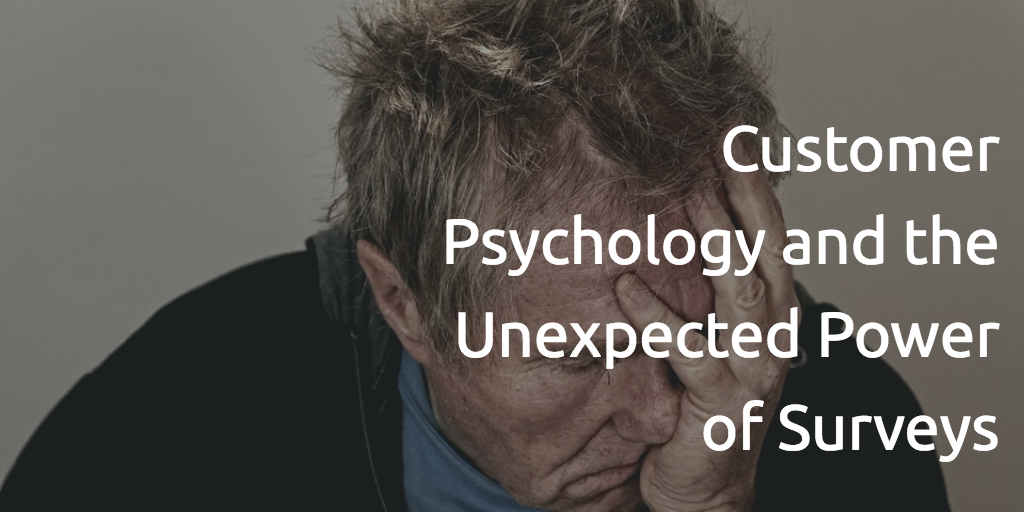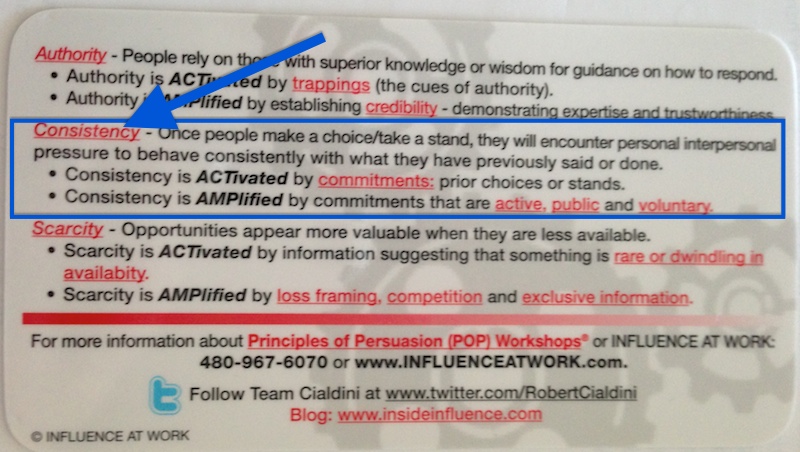 Surveys can be dangerous if used wrong, but can be super-powerful if used correctly!
Surveys can be dangerous if used wrong, but can be super-powerful if used correctly!
Whether it’s the Net Promoter System to gauge customer satisfaction, doing pre-launch customer development work for your startup, or one of the myriad methods we use to interact with and learn from our customers, prospects, and other people, surveys are by far the easiest to implement and most effective feedback mechanism at scale.
The problem with surveys, aside from all the ways that people generally mess them up (too many questions, leading the witness, not specific enough, poorly targeting / segmenting the audience, etc.), is that the underlying psychology of surveys is rarely taken into consideration.
Now I’ve said before that I’m not a big city psychologist, but I spend a lot of time studying psychology and human behavior as I try to figure out why people do what they do and also how to get them to do what I want them to do.
And some of that studying led me to realize that many of the behaviors we employ around surveys – especially in the Customer Success world with the use of NPS surveys – can have a very negative impact that does the exact opposite of what we’re trying to do.
In this article, I explore how we use surveys and suffer the often unintended consequences.
Now, I’m sure there are edge cases that don’t fit one of these categories or ways to get much more granular, but in my experience there are…
Three Use Cases for Surveys
If we look at surveys from a high-level, there are really only three reasons to send a survey:
- Learn things you don’t know
- Validate your assumptions
- Get the recipient to validate and recommit to their beliefs
The first two use cases – learn things you don’t know and validate your assumptions – are relatively self-explanatory so I won’t spend any time on those.
But the third use case is less well-known and interesting as it’s both incredibly powerful but dangerous if misused.
And a lot of people accidentally and unknowingly fall into the third use case while trying to solve for the first two.
Let me explain by starting with….
Cialdini’s Principle of Consistency
Once again we’ll be returning to the work of Dr. Robert Cialdini, his book influence, and his ideas around the Principles of Persuasion.
 In fact, we can look at my wallet-sized card that I got when I spent some time with the Influence at Work folks for the definition of the Principle of Consistency: “Once people make a choice/take a stand, they will encounter interpersonal pressure to behave consistently with what they have previously said or done.“
In fact, we can look at my wallet-sized card that I got when I spent some time with the Influence at Work folks for the definition of the Principle of Consistency: “Once people make a choice/take a stand, they will encounter interpersonal pressure to behave consistently with what they have previously said or done.“
Most marketers use the concepts posited by Dr. Cialdini as a way to elicit certain behaviors from their customers, which is valid.
But most marketers (and Customer Success people) would be wise to really understand what’s going on with these principles and how misusing them can have the exact opposite effect of what we’re trying to achieve!
For instance, when I talk about customer onboarding with my clients, I often talk about the Principle of Consistency.
This very simple-yet-powerful idea that once you do something or state your intention to do something, your next behavior will most likely be in-line with what you already committed to or have done.
And the reason this happens has nothing to do with how likely we are to stick with commitments we made, our willpower, or how good of a person we are.
These Principles of Persuasion, Consistency being one, are powerful because our brains are wired to work in this way; they happen outside of our conscious effort and whether we know they’re happening or not.
So because this isn’t a choice or just how we operate, it’s just the way our brains work, if we do the wrong thing or something that is incongruent with the positive outcome that we want from our customers, the principle still kicks in!
We don’t get to pick and choose when these principles work, so you have to be very careful out there.
Let’s explore how this applies to…
Surveys with Customer Success in Mind
When we send a survey – NPS or otherwise – asking about someone’s experience when they had a bad experience might seem good because we learn from their experience, we give them a place to vent, etc.
But the reality of the situation is if they’re upset and they get to voice and otherwise re-commit to that negative belief around your product or service in a way maybe they hadn’t done to date, we may be enabling consistency where we otherwise don’t want it to exist.
So while surveying the customer and finding out that they’re unhappy is good if we didn’t know that going in (definitely one of the valid use cases for surveys), you can still lead them down a path of being of acting consistently with that negative view of your company product or service.
In Customer Success, where we take a proactive approach to helping customers achieve their Desired Outcome, we should know whether a customer is on the right path to achieve that Desired Outcome, we should know whether they’re successful, and to a certain degree we should know whether they’re happy (even if were not trying to solve for happy).
From a Customer Success standpoint, we should know that a customer isn’t in a good place and simply not send a survey asking how they like our product or service and if they’d be willing to tell a friend. Makes sense, right?
It’s simple…
Don’t Knowingly Survey Unhappy Customers
Knowingly surveying a customer that is not achieving their Desired Outcome or is otherwise unhappy is a recipe for disaster as you activate the Consistency principle around that negativity.
And since you already know they’re not successful, you’re not trying to learn something you don’t know… so why are you surveying them? Right.
So never send a survey asking if they would recommend you to a colleague if you know they wouldn’t. Ever.
Don’t get me wrong, though… you absolutely should contact unhappy / unsuccessful customers to help them get back on track toward success, it’s just that a survey is not the right approach. Reach out and help them instead.
Okay, so that said…
If you Don’t Know, Survey a Small Cohort
While the damage may occur by surveying customers who are unhappy, if you don’t know that they’re unhappy and have no other way of determining that outside of the survey, then you have to do it. That’s a valid use case for a survey.
But you still need to be careful.
You might try surveying a subset of customers and looking for patterns with those who said they aren’t happy.
Then go back and identify customers that share those same characteristics and, instead of a survey, reach out to help them achieve their desired outcome.
You went from not knowing to knowing by surveying only a few customers – and invoking the Principle of Consistency with those few people – but once you knew, you didn’t need to survey anymore.
No matter what, I encourage everyone who conducts surveys for marketing, Customer Success, or whatever, to really understand…
The Psychological Impact of Surveys
The power of Consistency in surveys is really interesting.
Surveys can introduce new ways of thinking about a subject by way of phrasing the questions and then activate consistency on that new way of thinking.
Some companies use surveys in the sales process to gather and share insights with prospects. This helps start a conversation while also activating the principle of consistency.
If you understand the three use cases and the underlying psychology of surveys – especially around Cialdini’s Principle of Consistency – you can actually turn your surveys into a Growth Hack and make your customers successful (and happy).
One of the ways you can do that is to…
Use Surveys to Reinforce Positive Feelings
I said not to survey customers that you know are not happy. On the flip side, you absolutely want to survey customers who are achieving their Desired Outcome.
In fact, the best time to send an NPS survey – at least from my point of view, which isn’t completely aligned with NPS purists – isn’t just after any interaction with your company or on a timed interval, but once they’ve achieved a success milestone.
Yes, your results from an NPS survey will be skewed towards the positive and I know that flies in the face of NPS dogma, but it does amazing things to get the recipient to validate and recommit to their beliefs!
And when they come back and say they will absolutely be a promoter for you, close that loop and get them to take an action to be an advocate for you, to spread the word to invite their friends or colleagues and you just created a growth hack around your NPS survey.
So yes, there are reasons to send a survey when you already know the answer; it’s about reinforcing what the recipient already believes.
Remember, taking some time to understand psychology and how our brains work can massively improve your Customer Success and Marketing efforts.
The mind is a terrible thing to waste…



